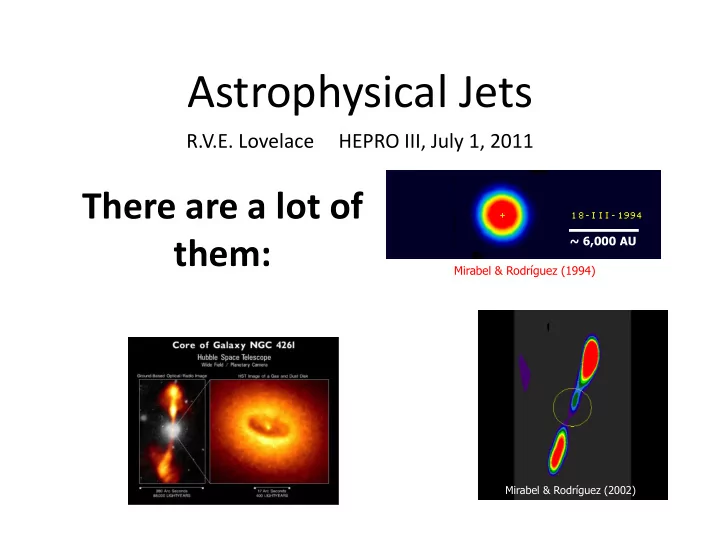

Astrophysical Jets R.V.E. Lovelace HEPRO III, July 1, 2011 There are a lot of them: ~ 6,000 AU Mirabel & Rodríguez (1994) Mirabel & Rodríguez (2002)
M87 at 2cm –VLA Owen et al. 1989, ApJ, 340, 698 Resolution 0.1". Field of View 10.00” x 15.00” 0.08 kpc
Theoretical Models of Jets: (a very concise summary) Require large‐scale magnetic fields.
Advection and compression of a weak field leads to a strong field in the inner disk. Bisnovatyi‐Kogan & Ruzmaikin 1976
Lovelace(1975,1976) (a Poynting‐flux jet) Blandford (1976) Lovelace Nature
� Faraday disk dynamo I B B tot E E accretion v � disk r r 2 1 /c E = - v B r z Lovelace 1975, 1976
� B v � r r 2 1 /c E = - v B r z
First measurement of current flow in an extra‐galactic jet Kronberg, Lovelace, Lapenta, & Colgate, 2011, ApJL, in press arXiv:1106.1397 7kpc 2kpc E3 E2 E1 3C 303, z=0.14
Kronberg et al., 2011 I z
From Kronberg et al. (2011): I_z = 3.*10^17 A L_j =3.*10^36 W ________
From Kronberg et al. (2011): Benford, 1978, MNRAS, 183, 29 Nakamura, et al., 2008, ApJ, 686, 843
E3 I return I AGN disk
Advection/Diffusion of the B field: Bisnovatyi‐Kogan & Ruzmaikin 1976
But problems with this idea were discovered in the 1990’s • Turbulence responsible for accretion also leads to enhanced reconnection (field diffusivity) • A turbulent disk is a poor conductor • Weak fields do not advect inward in a thin disk disk
How might weak magnetic fields be able to advect? inward • Could be achieved with a mathematically favorable vertical profile of the diffusivity (Ogilvie & Livio 2001) • Physical model: Assuming the surface layer of the disk is nonturbulent (i.e., highly conducting), it can support inward field advection: Bisnovatyi-Kogan & Lovelace (2011); Lovelace, Rothstein, & Bisnovatyi-Kogan (2009,ApJ);Rothstein &Lovelace(2008,ApJ);Bisnovatyi- Kogan & Lovelace (2007, ApJ)
The Basic Idea Advection in a nonturbulent surface layer Accretion Velocity
Disk‐jet connection advected magnetic field Signature of Jet Ejection Disk turbulent disk jet timescales ~ 20 min Observations of GRS 1915+105 (see also Tagger et al. 2004) (Eikenberry et al. 1998; Rothstein et al. 2005)
Bisnovatyi‐Kogan & Lovelace (2011) g(z) z h
Parameters: three coefficients of solution; alpha=viscosity; epsilon=h/r; and beta. Need to vary beta in order to satisfy all of the boundary conditions.
average(beta) =100
Conclusions Regarding Advection/ Diffusion of B Field • There is a critical value of beta for stationary conditions of an accretion disk threaded by a poloidal magnetic field. • It is approximately beta =240 for a turbulent Prandtl # = 1, alpha = 0.1, and h/r = 0.05. • . For smaller beta the field advects inward whereas for larger beta the field diffuses outward (Bisnovatyi‐Kogan and Lovelace 2011).
Conclusions Regarding Current Flow in kpc Jets (Kronberg et al. 2011): • Poynting Flux Jet. Beta << 1. • Axial current I ~ 10 18 A. • Jet Power = I 2 Z with Z ~ 30 Ohms.
Ceiling of Gaudi’s Sagreda Familia Barcelona
Recommend
More recommend